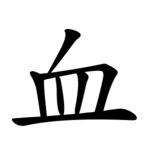| 血 | ||
|---|---|---|
| ||
| 血 (U+8840) "blood" | ||
| Pronunciations | ||
| Pinyin: | xuè | |
| Bopomofo: | ㄒㄩㄝˋ | |
| Wade–Giles: | hsüeh4 | |
| Cantonese Yale: | hyut3 | |
| Jyutping: | hyut3 | |
| Japanese Kana: | ケツ ketsu / ケチ kechi (on'yomi) ち chi (kun'yomi) | |
| Sino-Korean: | 혈 hyeol | |
| Names | ||
| Japanese name(s): | 血/ち chi (Left) 血偏/ちへん chihen | |
| Hangul: | 피 pi | |
| Stroke order animation | ||
 | ||
Radical 143 or radical blood (血部) meaning "blood" is one of the 29 Kangxi radicals (214 radicals in total) composed of 6 strokes.
In the Kangxi Dictionary, there are 60 characters (out of 49,030) to be found under this radical.
血 is also the 138th indexing component in the Table of Indexing Chinese Character Components predominantly adopted by Simplified Chinese dictionaries published in mainland China.
Evolution
 Oracle bone script character
Oracle bone script character Large seal script character
Large seal script character Small seal script character
Small seal script character
Derived characters
| Strokes | Characters |
|---|---|
| +0 | 血 |
| +3 | 衁 衂 (=衄) |
| +4 | 衃 衄 |
| +5 | 衅SC (=釁 -> 酉) |
| +6 | 衆JP/KO/GB TC (=眾 -> 目) 衇 (=脈 -> 肉) 衈 衉 |
| +15 | 衊 |
| +18 | 衋 |
Sinogram
As an independent sinogram it is one of the Kyōiku kanji or Kanji taught in elementary school in Japan.[1] Specifically it is a third grade kanji.[1]
References
- 1 2 "The Kyoiku Kanji (教育漢字) - Kanshudo". www.kanshudo.com. Archived from the original on March 24, 2022. Retrieved 2023-05-06.
Further reading
- Fazzioli, Edoardo (1987). Chinese calligraphy : from pictograph to ideogram : the history of 214 essential Chinese/Japanese characters. calligraphy by Rebecca Hon Ko. New York: Abbeville Press. ISBN 0-89659-774-1.
External links
Wikimedia Commons has media related to Radical 143.
This article is issued from Wikipedia. The text is licensed under Creative Commons - Attribution - Sharealike. Additional terms may apply for the media files.